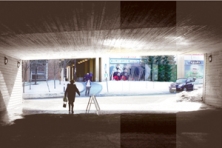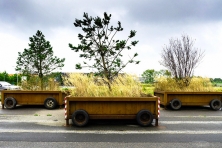Social Riverscape
Bærum (NO) – Winner
TEAM DATA
Team Representative: Hanna Haukøya Storemyr (NO) – landscape architect; Associate: Sigrid Urnes (NO) – landscape architect
Theresesgate 32 c, leil. 402, 0168 Oslo – Norge
+47 47 633 075 – hauk.storemyr@gmail.com
See the complete listing of portraits here
See the site page here

S. Urnes and H. Haukøya Storemyr
INTERVIEW
1. How did you form the team for the competition?
Team Urnes and Storemyr was formed during our diploma, in the spring of 2013, and we gathered around a mutual sense of exploration. This diploma was the base for our Europan proposal – “Social Riverscape”.
2. How do you define the main issue of your project, insisting on how you answered on this session main topic: adaptability and urban rhythms?
Our environment is always changing. We see these changes as “layers of change”, which need to harmonize so that a site can be adaptable. We believe urban design should create a framework that can handle the changes in nature, in the built environment and in the way people use the city. In our proposal we show how landscape can form a base for future, sustainable development.
3. How did this issue and the questions raised by the site mutation meet?
In Sandvika, we found that the main issue of adaptability is that these layers of changes developed independently from each other. One example is the densification of the city centre, with housing initially intended for commuters. However, in reality it is the elder people that cannot live by themselves in their single house dwellings in the suburbs. It all appears as a paradox when considering these different layers of change, with the urban development and people’s rhythms. This resulted in a city marked by volatility and making Sandvika a “vein junction”.

4. Have you already treated this issue previously and could you present some reference projects that inspired yours?
When working with adapting to changes in rhythms, fabric and nature, there are approaches from very different projects that inspired us. Fredericia C by SLA has been an inspiration because of their approach to urban planning; seeing nature's processes and systems, and not just the æsthetics or appearance of nature, as a basis for all planning. It also inspired us in the way they integrate temporality in the long-term urban development. Collective typologies have also been an important issue for us in order to make a flexible and sustainable framework for living. Lange Eng –a collective housing project by Dorte Mandrup Arkitekter– accommodates both individual and social needs. When working with a unique waterscape like the meandering river of Sandvika, we found inspiration in the National Tourists Routes of Norway with cautious and site-specific interventions that highlight and accentuate Norwegian landscapes.

5. Today –within the era of an economic crisis and sustainability– the urban-architectural project should reconsider its production method in time; how did you integrate this issue in your project?
Our proposal forms a flexible framework around the Sandvika river as a strong structuring element. The given premises of the river form a flexible framework for the site to develop in different ways, in different phases. We believe that such flexibility is essential in today's urban planning. As landscape architects we wish to create frameworks where everyday life can unfold, using the specific possibilities of each site. We proposed a first intervention in order to integrate and activate the site already before the physical development starts. Such interventions could contribute to a more dynamic development and fill time gaps.
6. Is it the first time you have been awarded a prize at Europan? How could this help you in your professional career?
“Social Riverscape” is our first Europan poposal, and our first project as a team. We are excited to continue the dialog with the Bærum Municipality and to contribute in the future development on Hamang. Besides this, winning Europan has been a kickstart for us as a team, inspiring us to continue working together. Europan has given us new connections and experiences that are of great importance in future collaborations and establishment.